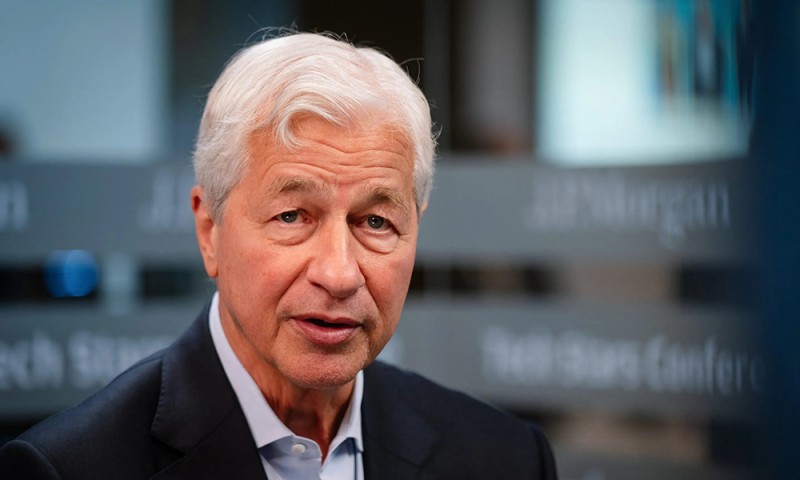
杰米·戴蒙本周可谓风光无限:在摩根大通公布最新亮眼财报之际,这位华尔街极具影响力(甚至有人认为是最具影响力)的人物发表了诸多见解。周二,这位投行首席执行官现身华盛顿特区,与《财富》杂志总编尚艾俪(Alyson Shontell)共同出席“最具影响力商界女性峰会”。当话题转向2025年最热门议题——人工智能是否存在泡沫时,戴蒙表示这一说法并不完全准确,但他同时重申近期反复强调的观点:“人们不应再对失业问题视而不见。”
“人工智能会淘汰工作岗位,”戴蒙指出,其情形就如同当年拖拉机与汽车问世时一样。“技术变革日新月异,”他如此形容突如其来的颠覆性变革,并敦促社会、政府和企业共同“探索保就业之道”,无论是通过再培训、提供新收入形式,还是推行提前退休政策。他强调必须采取措施:“不能让这些人沦落街头……当他们的年薪从15万美元骤降至3万美元时,社会动荡在所难免。”
他坚称这项突破真实存在且不容小觑。“人工智能本身是真实存在的,”他宣称,明确表示这项底层技术既具颠覆性又有持久性。“你们应当运用这项技术,”他对所有听众如是说。但他发出警示:1996年时“互联网同样真实存在”,“当时整个行业看起来就像一场泡沫”。随后他剖析了人工智能与生成式人工智能的本质差异。戴蒙强调这点至关重要,同时承认“某些资产价格偏高,已处于某种泡沫区间”。
泡沫之争
戴蒙将当前的人工智能热潮与互联网发展初期的情况作了对比,称互联网发展初期“从整体来看,是有所回报的”,因为谷歌、油管(YouTube)和Meta最终成功崛起,且长期屹立不倒。他表示对当前市场状况持一定的谨慎态度,但敦促人们不要简单地将所有人工智能都贴上投机狂热的标签。"你不能将人工智能整体视为泡沫,尽管其中某些领域可能存在泡沫。总体而言,它终将带来回报。“他坦言部分项目不会按原计划推进,另一些则能获得所需支持,但拒绝讨论个例,主张对投资进行个案评估。就在数日前,戴蒙在接受英国广播公司(BBC)采访时还警告称,美股有30%的概率出现回调,自称“比其他人担忧得多”。
在戴蒙的领导下,摩根大通自2012年起已在人工智能和机器学习领域投入数十亿美元,目前有超过2000名员工专职从事人工智能相关工作,且已有数百项应用投入使用。他透露,这些投入已带来切实收益,节省的成本或创造的新收入流价值超20亿美元。戴蒙表示,人工智能已无缝融入摩根大通的运营体系,从欺诈防范、客户服务到复杂法律文件分析均有应用。
这位首席执行官作出关键区分:该行将人工智能应用于风险管控、欺诈防范以及市场营销等“极为具体的领域”,且已见证其成效。他认为人工智能的应用有时难以与单纯的流程改进区分开来,就像进入新工作流程后,“突然发现员工数量减少了40%”。
但对于以“幻觉”问题著称的生成式人工智能,戴蒙将其归为“另一类”。他表示,生成式人工智能的效率提升多为传闻,比如有人称它节省了数小时工时。“但这究竟值多少钱?你是不是花两小时时间做了其他事?我们其实并不清楚。”针对麻省理工学院(MIT)一项颇具影响力的研究——该研究发现95%的生成式人工智能试点项目未能实现投资回报,戴蒙认为,过于精确地计算效率会陷入误区:“我们投入大量资金将数据整理成人工智能可用的格式,我们只是在推进这件事,并没有核算成本。”他强调数据准确性至关重要,效率自然会随之提升。戴蒙补充道,他曾与其他公司的首席执行官朋友通电话,发现大多数人工智能应用“确实有效”,但也承认部分应用可能不尽如人意。
大师班
在这个快速变革的时代,戴蒙认为灵活应变与保持谦逊至关重要。“运用它,精通它,让它成为你工具箱和武器库的一部分,你会在这个过程中不断学习。人工智能本身也会不断得到改进。”他建议其他企业高管持续投入员工培训与适应能力建设。摩根大通甚至开始安排管理者参加人工智能“大师班”,以提升技能、拓展组织专业能力。
随着全球人工智能投资热潮持续推动市场发展——据估算,2025年人工智能对美国国内生产总值增长的贡献率将达到40%——戴蒙的观点因其坦率与审慎而显得尤为突出。这位务实派人士呼吁出台审慎的监管政策、建立强有力的保障体系,并制定周密计划,以减轻人工智能带来的冲击,同时把握其带来的机遇。对政策制定者和企业领导者而言,戴蒙的警示清晰明确:人工智能时代已然来临,最糟糕的应对方式便是否认或拖延。(*)
译者:中慧言-王芳
杰米·戴蒙本周可谓风光无限:在摩根大通公布最新亮眼财报之际,这位华尔街极具影响力(甚至有人认为是最具影响力)的人物发表了诸多见解。周二,这位投行首席执行官现身华盛顿特区,与《财富》杂志总编尚艾俪(Alyson Shontell)共同出席“最具影响力商界女性峰会”。当话题转向2025年最热门议题——人工智能是否存在泡沫时,戴蒙表示这一说法并不完全准确,但他同时重申近期反复强调的观点:“人们不应再对失业问题视而不见。”
“人工智能会淘汰工作岗位,”戴蒙指出,其情形就如同当年拖拉机与汽车问世时一样。“技术变革日新月异,”他如此形容突如其来的颠覆性变革,并敦促社会、政府和企业共同“探索保就业之道”,无论是通过再培训、提供新收入形式,还是推行提前退休政策。他强调必须采取措施:“不能让这些人沦落街头……当他们的年薪从15万美元骤降至3万美元时,社会动荡在所难免。”
他坚称这项突破真实存在且不容小觑。“人工智能本身是真实存在的,”他宣称,明确表示这项底层技术既具颠覆性又有持久性。“你们应当运用这项技术,”他对所有听众如是说。但他发出警示:1996年时“互联网同样真实存在”,“当时整个行业看起来就像一场泡沫”。随后他剖析了人工智能与生成式人工智能的本质差异。戴蒙强调这点至关重要,同时承认“某些资产价格偏高,已处于某种泡沫区间”。
泡沫之争
戴蒙将当前的人工智能热潮与互联网发展初期的情况作了对比,称互联网发展初期“从整体来看,是有所回报的”,因为谷歌、油管(YouTube)和Meta最终成功崛起,且长期屹立不倒。他表示对当前市场状况持一定的谨慎态度,但敦促人们不要简单地将所有人工智能都贴上投机狂热的标签。"你不能将人工智能整体视为泡沫,尽管其中某些领域可能存在泡沫。总体而言,它终将带来回报。“他坦言部分项目不会按原计划推进,另一些则能获得所需支持,但拒绝讨论个例,主张对投资进行个案评估。就在数日前,戴蒙在接受英国广播公司(BBC)采访时还警告称,美股有30%的概率出现回调,自称“比其他人担忧得多”。
在戴蒙的领导下,摩根大通自2012年起已在人工智能和机器学习领域投入数十亿美元,目前有超过2000名员工专职从事人工智能相关工作,且已有数百项应用投入使用。他透露,这些投入已带来切实收益,节省的成本或创造的新收入流价值超20亿美元。戴蒙表示,人工智能已无缝融入摩根大通的运营体系,从欺诈防范、客户服务到复杂法律文件分析均有应用。
这位首席执行官作出关键区分:该行将人工智能应用于风险管控、欺诈防范以及市场营销等“极为具体的领域”,且已见证其成效。他认为人工智能的应用有时难以与单纯的流程改进区分开来,就像进入新工作流程后,“突然发现员工数量减少了40%”。
但对于以“幻觉”问题著称的生成式人工智能,戴蒙将其归为“另一类”。他表示,生成式人工智能的效率提升多为传闻,比如有人称它节省了数小时工时。“但这究竟值多少钱?你是不是花两小时时间做了其他事?我们其实并不清楚。”针对麻省理工学院(MIT)一项颇具影响力的研究——该研究发现95%的生成式人工智能试点项目未能实现投资回报,戴蒙认为,过于精确地计算效率会陷入误区:“我们投入大量资金将数据整理成人工智能可用的格式,我们只是在推进这件事,并没有核算成本。”他强调数据准确性至关重要,效率自然会随之提升。戴蒙补充道,他曾与其他公司的首席执行官朋友通电话,发现大多数人工智能应用“确实有效”,但也承认部分应用可能不尽如人意。
大师班
在这个快速变革的时代,戴蒙认为灵活应变与保持谦逊至关重要。“运用它,精通它,让它成为你工具箱和武器库的一部分,你会在这个过程中不断学习。人工智能本身也会不断得到改进。”他建议其他企业高管持续投入员工培训与适应能力建设。摩根大通甚至开始安排管理者参加人工智能“大师班”,以提升技能、拓展组织专业能力。
随着全球人工智能投资热潮持续推动市场发展——据估算,2025年人工智能对美国国内生产总值增长的贡献率将达到40%——戴蒙的观点因其坦率与审慎而显得尤为突出。这位务实派人士呼吁出台审慎的监管政策、建立强有力的保障体系,并制定周密计划,以减轻人工智能带来的冲击,同时把握其带来的机遇。对政策制定者和企业领导者而言,戴蒙的警示清晰明确:人工智能时代已然来临,最糟糕的应对方式便是否认或拖延。(*)
译者:中慧言-王芳
Jamie Dimon has had a big week: As JPMorgan released its latest blockbuster earnings, he held forth as a leading (some would say the leading) voice on Wall Street. The investment bank CEO was in Washington, D.C., on Tuesday, appearing at the Fortune Most Powerful Women Summit with editor-in-chief Alyson Shontell, when the subject turned to everyone’s favorite conversation in 2025: the AI bubble, or lack thereof. Dimon said that isn’t quite right in his opinion, but also that he thinks “people should stop sticking their head in the sand” on the subject of job loss, reiterating a favorite recent refrain of his.
“It will eliminate jobs,” Dimon said, pointing out that so did tractors and cars, once upon a time. “It happens too fast,” he said, referring to sudden, disruptive technological change. He urged society, government, and business to “figure out how we can save jobs,” whether that’s through retraining, a new form of income, early retirement, he said there’s a need for “something—you can’t just take all these people and throw them on the street … making $30,000 a year when they were making [$150,000], you’ll have a revolution.”
He insisted that the breakthrough is genuine and worth taking seriously. “AI itself is real,” he declared, making clear that he sees the underlying technology as both transformative and enduring. “You should be using it,” he said, speaking to any business that was listening. But he added a caveat, saying that back in 1996, “the internet was real,” and “you could look at the whole thing like it was a bubble.” Then he broke down the real difference that he sees—between AI, on the one hand, and generative AI, on the other. It’s an important distinction, Dimon said, while adding that “some asset prices are high, in some form of bubble territory.”
Bubble or not
Dimon compared today’s AI exuberance to the early days of the internet, calling that “in total, a payoff,” as Google, YouTube, and Meta eventually emerged and proved durable. He said he was somewhat cautious about conditions in the current market, yet he urged people not to simply label all of AI as a speculative frenzy. “You can’t look at AI as a bubble, though some of these things may be in the bubble. In total, it’ll probably pay off.” He said some projects won’t be done the way they were announced, others will get the power they need, but he declined to discuss them in particular, urging a case-by-case evaluation of investments. Just days earlier, Dimon had warned in a BBC interview that he saw a 30% chance of a correction in the stock market, calling himself “far more worried than others.”
Under Dimon’s leadership, JPMorgan has invested billions in artificial intelligence and machine learning since 2012, with more than 2,000 staff now dedicated to AI and hundreds of applications in production. He has cited tangible benefits worth upwards of $2 billion in cost savings or new revenue streams. Dimon described AI as being seamlessly embedded in JPMorgan’s operations, from fraud prevention to customer service to the analysis of complex legal documents.
The CEO made a crucial distinction, saying that his bank has applied AI to “very specific things” such as risk and fraud and marketing, and he’s seen that it works. He argued that AI adoption is sometimes hard to distinguish from pure procedural improvement, likening it to going into a new work stream, “and all of a sudden your headcount’s down 40%.”
But Dimon put generative AI, which is famously prone to hallucination, in “the other category.” He said this is largely anecdotal in terms of efficiencies, with some people arguing it saves them hours. “What’s that worth? Did you just spend two hours doing something else? We don’t really know.” Responding to the influential MIT study that found 95% of generative AI pilots had failed to yield return on investment, Dimon said he thinks it’s a mistake to try to calculate everything so carefully in terms of efficiencies: “We spend a lot of money getting data into the proper format, so it’ll be used by AI. We’re just doing it. We’re not measuring how much it costs.” Getting the data right is imperative, he argued, and then efficiencies will follow. Dimon added that he calls friends at other companies, other CEOs, and most AI adoption stories “actually work,” acknowledging that some are maybe disappointed, too.
The master class
For Dimon, agility and humility are paramount in this era of rapid change. “Use it. Get good at it. Make it part of your tool set, your weapon set, and you’ll learn. It’ll get better all the time.” He advised fellow executives to make ongoing investments in training and adaptation. JPMorgan has even begun sending managers to AI “master classes” to deepen their skills and broaden organizational expertise.
As the global AI investment boom continues to lift markets—accounting for an estimated 40% of U.S. GDP growth in 2025—Dimon’s voice stands out for its candor and caution. Ever the pragmatist, he called for thoughtful regulation, robust safety nets, and deliberate planning to mitigate AI’s impacts and harness its opportunities. For policy and corporate leaders alike, Dimon’s message is unmistakable: The AI era is here, and the worst response is denial or delay.

